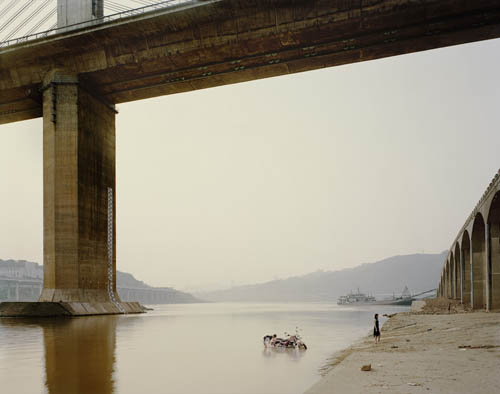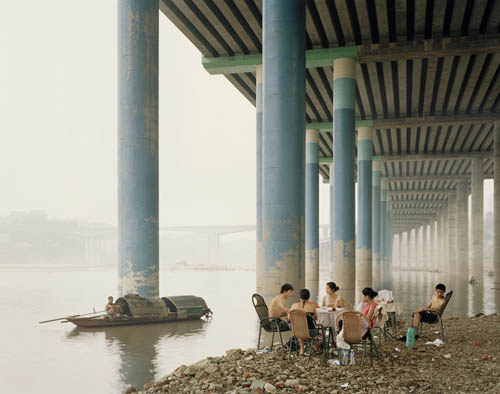The Long River

[Image: "Chongqing XI" by Nadav Kander, winner of the 2009 Prix Pictet; courtesy of the Prix Pictet].
Speaking of the Prix Pictet, the winner of the 2009 prize was Nadav Kander for his project Yangtze, The Long River. It's an amazing group of images.
From Kander's artist statement:
- The Yangtze River, which forms the premise to this body of work, is the main artery that flows 4100 miles (6500km) across china, traveling from its furthest westerly point in Qinghai Province to Shanghai in the east. The river is embedded in the consciousness of the Chinese, even for those who live thousands of miles from the river. It plays a significant role in both the spiritual and physical life of the people.

[Image: "Chongqing VII, (Washing Bike)" by Nadav Kander; courtesy of the Prix Pictet].
Part of Kander's visual goal was "showing humans dwarfed by their surroundings. Common man," the photographer adds, "has little say in China’s progression and this smallness of the individual is alluded to in the work."
The images featured in this post have the feel of a film set—more cinematography than photography—as if Kander has unknowingly captured a mise-en-scène, some wrongly cut dramatic moment, unfolding on the river banks.
Actors, perhaps unsure of their larger narrative role, seem overwhelmed by their infrastructural surroundings.

[Image: "Chongqing IV (Sunday Picnic)" by Nadav Kander; courtesy of the Prix Pictet].
The stage set-design theories of Edward Gordon Craig come to mind. Craig was an early 20th-century stage set designer (and son of an architect), whose "architectonic scenery," according to M. Christine Boyer, foregrounded architectural backdrops so strongly that his props ultimately became the only on-stage action an audience was meant to watch.
Craig "proposed that a stage in which walls and shapes rose up and opened out, unfolded or retreated in endless motion could become a performance without any actors," Boyer writes. "The stage thus became a device to receive the play of light rhythmically, creating an endless variety of mobile cubic shapes and varying spaces. Deep wells, stairs, open spaces, platforms, or partitions created a stage of complete mobility, which Craig believed appealed to the imagination." It is a stage devoid of actors, in other words, just large pieces of equipment moving about according to the rules of their own choreography.
What happens, then, if this depopulated dramaturgy becomes blown-up to the scale of national infrastructure?
In one sense, this perfectly empty landscape into which humans try vainly—and at great emotional cost—to situate themselves is the hallmark of J.G. Ballard. We might even specifically ask, looking at Kander's photos: when will a Yangtze River-based rewriting of Ballard's Concrete Island come along, exploring these spatial questions?
Concrete Island, of course, is Ballard's 1974 novel about a London motorist—as it happens, an architect—who is stranded on his way home by a car accident. Freeing himself from his ruined vehicle at sundown, he finds himself trapped beneath the yawning arches of the motorway, stranded in a peripheral world of drainage culverts, ascent ramps, sliproads, and storm tunnels, a kind of urban blindspot (read Mike Bonsall's awesome forensic archaeology of London's Westway, a spatial interrogation of the built environment in order to discover where Ballard's novel was meant to be set).
With no rescue in sight, Ballard's architect is left to fend for himself, surrounded by gigantic pieces of urban infrastructure whose purpose now seems oddly counter-human; he is "alone in this forgotten world whose furthest shores were defined only by the roar of automobile engines... an alien planet abandoned by its inhabitants, a race of motorway builders who had long since vanished but had bequeathed to him this concrete wilderness."
I'm left wondering: who is the J.G. Ballard of contemporary China? Nadav Kander's photographs—many more of which can be seen at the Prix Pictet site—are an enticing glimpse of what a Ballardian sensibility might create there.





Comments are moderated.
If it's not spam, it will appear here shortly!
I love the idea of Man lost in a landscape partly of his own creation, but more often imposed by other people, or (still) by Nature herself. I think it beautifully illustrates the sense of powerlessness felt by much of the modern world. We are still fighting for personal power and survival, but less against Nature and more against the impositions of other Men, against which we are contrained in ways we weren't in times past when struggling for survival in the natural world.
loved the Hatakeyama set at prixpictet, thanks a lot for the link.
cheers!
Post a Comment